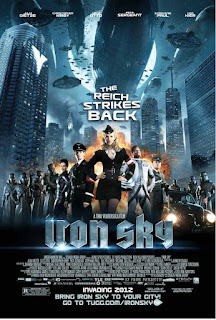Ralph E. Vaughan's Blog
October 30, 2022
Bedtime Stories
I am the first one to admit, I spend far too much time on YouTube. On the other hand, it is much less a time waster than Facebook (which I visit occasionally) or Twitter (which I abandoned completely because of the endless and ever-growing tide of liberal hate), and it is often a source of vital information. After all, where else are you going to find short, easily digestible videos about the important things in life--meteor impacts, steampunk music, model building, zombies, woodworking, dogs, UFOs, traffic accidents in Chula Vista, ancient, civilizations, volcanoes, comic books, the Fermi Paradox, abandoned shopping malls, silly rants, science fiction, the foibles of humanity, old TV series, Simulation Theory, and, of course, kittens?
Now and then, something I watch on YouTube leads me to a new book. I found out about The Three Body Problem on a channel called Quinn's Ideas...smart fellow, that Quinn. And all the hullabaloo about that terrible Rings of Power series (Amazon itself soured me with their own teasers, trailers and first fifteen minutes of the series) led me back to rereading LOTR after more than fifty years...overwritten, surely, but Tolkien's facility with the English language makes you wish he had overwritten more. From Gary Lovisi's channel, I learned about a novel featuring HP Lovecraft and Robert E. Howard as characters...a little embarrassing, that one, since it was published twenty years ago, and I should have known about it. And sometimes a channel leads me to an unexpected and pleasant surprise.
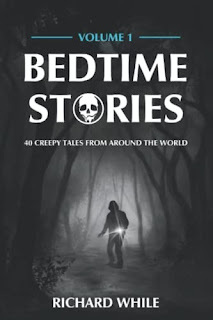 ISBN 979-8435530322
ISBN 979-8435530322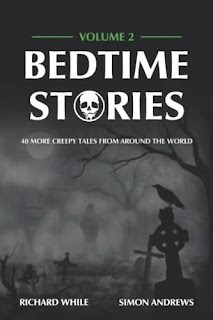 ISBN 979-8835857425
ISBN 979-8835857425I've been a fan of the YouTube channel Bedtime Stories for several months. Despite the name, the stories they relate are not the kind of nighttime tales you want to tell your kids before they go to sleep, not if you actually want them to go to sleep. The fare offered touches upon aliens, ghosts, mysteries, unexplained phenomena, true crime, odd deaths and urban legends. They are delivered in a delightful English accent (Yorkshire?) and are accompanied by evocative art with some animated effects. The channel has been around for five years, so I have been slowly working my way through past episodes. In one of them, they mentioned the publication of two books, each containing forty stories previously presented to viewers.
I was hesitant when I heard the word "transcripts," but I took author Richard While at his word that the chapters were more than verbatim copies of the episodes. He was correct. The reader gets revisions, added information, further speculation, and, sometimes, corrections...no matter how thorough one may be in researching, authors are fallible creatures, but one of the strengths of Richard and his colleagues is that they never really close a case, always searching for more information as investigations turn up new data and witnesses.
The stories really are a mixed bag. In the first forty tales we have the high strangeness of "The Ikley Moor Alien," the historical conundrum of "The Flannan Lighthouse Mystery," the very disturbing case of "The Body on the Reservoir" from Brazil, and my favorite, "There is Something in the Woods." In Volume Two, we have "The Lair of the Wendigo," an examination of the folklore also used by Ambrose Bierce in his classic story; "Tales from Skinwalker Ranch," looking into Indian legends and UFOlogy; the urban legend of "The Manchester Pusher," which asks the question of whether a secret serial killer might haunt Manchester, England (much like the perhaps-mythical Smiley Face Killer in America, also covered by the channel); and "The Kentucky Goblins," a UFO/demon story near and dear to me since I used to live just a stone's throw from Hopkinsville in the 70s.
If you like mysteries, unsolved crimes, paranormal phenomena, UFOs, cryptids, urban legends, ancient folklore impinging upon modern life, or wonder why so many people vanish without a trace in the national parks of America, these books might be of interest. They are available in paperback and in less expensive e-book versions. I got the paperbacks, myself. As one reviewer noted, the books are easy to pick up, but hard to put down. Me? All I say is, don't read the stories at bedtime.
October 2, 2022
Adventure of the Five Sherlocks
As most of you know, not only am I a huge fan of the Sherlock Holmes stories and films, I have written a fair share of stories featuring the Great Detective myself. I was also the first to introduce Sherlock Holmes to fantasy writer HP Lovecraft and his cadre of monster-gods, which I did in 1983 with "The Adventure of the Ancient Gods." I've published two collections of Holmes-related tales and provided a handful of stories for anthologies edited by others. The latest example of the latter is "The Adventure of the Five Sherlocks" in Mystery Magazine (formerly Mystery Weekly Magazine), a Canadian periodical, for its October 2022 number.
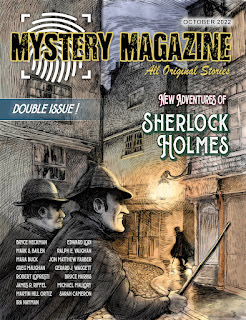 Mystery Magazine
Mystery MagazineOctober 2022
Special Sherlock Holmes Double Issue
I had provided two stories for previous issues, in 2017 and 2019. Both were tales having do with Lovecraft's Cthulhu Mythos, one set in the period between Holmes' apparent death and his return, the other narrated by a Bertie Wooster-like character. When editor Kerry Carter contacted me recently and asked if I had anything to contribute, I considered another foray into the Mythos, but I really wanted to do something completely different, especially since I am now working on my third and final collection of Sherlock Holmes stories, this time taking him into HP Lovecraft's Dreamlands, a wild ride to be sure.
Quite some time ago, I wrote the opening paragraphs to a story titled "The Adventure of the Five Sherlocks." As is often the case with me, I had the opening and I had the final lines of the story, but everything in-between was a little vague. Had Kerry not emailed me, who knows how long my protagonists would have sat in that chamber after their monthly dinner wondering what was going to happen next? Kerry's request spurred me to finish it in a couple of months.
The main characters are Basil Rathbone, Christopher Lee, Peter Cushing and Jeremy Brett, all actors known for, among other accomplishments, portraying the Immortal Detective on the screen. In case you're wondering, no, the story is not set in the past, when they were all contemporaries of each other, but, rather...later. Yes, I know they are all dead, but in the context of the story that really does not matter.
While I admire all of them for their acting skills and the entertainment they brought me over the years, I must admit Basil Rathbone is my favorite Sherlock Holmes, and that bias probably shows in the story as events unfold. What can I say? We all remember our first as being the best--Sean Connery as Bond, Roger Moore as The Saint, David Suchet as Hercule Poirot, John Nettles as DCI Barnaby, and Basil Rathbone as Sherlock Holmes.
The plot of the story is a bit "out there," but I don't want to go into it, lest too much be given away about the mysterious disappearance of Gaius Julius Caesar, the noblewoman who arrived with her barbarian bodyguards, and the mysterious girl who spoke an unknown language. Suffice it to say that it will entertain both Sherlock Holmes fans and movie buffs. If you want (should you decide to read it), you can even imagine the events of the story unfolding in glorious black and white, as the best films do.
I am not alone in this special issue of Mystery Magazine. I am joined by sixteen others, all presenting new adventures of Sherlock Holmes. It is quite the value. If mysteries are your thing, you might want to consider a digital subscription to the magazine, which will save you quite a bit.
August 31, 2022
Godzilla, My Godzilla
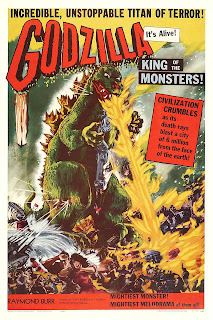 Godzilla and I have a lot in common. We were born the same year and are often misunderstood by the people around us. Additionally, we are both "big boned" (hefty or plus-sized as they say now), are prone to falls, and sometimes get hit in the head. Admittedly, though, for me it's not usually by skyscrapers, giant lobsters or boulders kicked by a rampaging dog-god, though Skylar did throw one of his chew toys at me a couple of weeks ago...yeah, it left a bruise. I also have not been dropped from the upper reaches of the stratosphere by flying alien three-headed dragon kaiju, but you just never know when things like that are going to happen. It's a crazy world these days.
Godzilla and I have a lot in common. We were born the same year and are often misunderstood by the people around us. Additionally, we are both "big boned" (hefty or plus-sized as they say now), are prone to falls, and sometimes get hit in the head. Admittedly, though, for me it's not usually by skyscrapers, giant lobsters or boulders kicked by a rampaging dog-god, though Skylar did throw one of his chew toys at me a couple of weeks ago...yeah, it left a bruise. I also have not been dropped from the upper reaches of the stratosphere by flying alien three-headed dragon kaiju, but you just never know when things like that are going to happen. It's a crazy world these days.Of course, there are differences too. Godzilla came from beneath the sea. I came from Michigan's Upper Peninsula, but still pretty close to the waters of the Great Lakes. He also has the form of a reptile, whereas I only have the emotions of one. His teeth are a lot better than mine, though I have had five wisdom teeth removed over the years...I still have three. So, while Godzilla has sturdy reptile teeth, I have the dodgy teeth of a geriatric shark, but only the wisdom teeth keep coming back. I suppose people who know me are surprised that I ever had wisdom teeth. Godzilla also has searing atomic breath that can (if the recent Godzilla vs Kong film from legendary is to be believed) burn a hole all the way through to the Hollow Earth. My breath, on the other hand...well, maybe we shouldn't go there.
Godzilla is famous worldwide, is the subject of the longest running film franchise, has become a cultural icon (and not just in Japan), and is considered a hero by many. For all that though, his origin is very dark, rooted in destruction and death. One day, Tomoyuki Tanaka, a film producer with Toho Company, Ltd, was flying back to Japan. Gazing out the window at the waters of the Pacific, he let his mind wander. What was in the impenetrable dark depths below? The year before, he had seen The Beast from 20,000 Fathoms, which was based on Ray Bradbury's story "The Fog Horn." Could something like that actually survive the ages? Maybe not, but what if there was something in the deeps that might be awakened? What would it take to rouse an avenging monster?
 The Lucky Dragon 5
The Lucky Dragon 5Also in Tanaka's mind was the fate of the Daigo Fukuryu Maru (Lucky Dragon 5), a fishing vessel with a crew of 23, which was very much in the news. In March of that year, the U.S. detonated the first hydrogen bomb at the Bikini Atoll, an operation designated the Castle Bravo Thermonuclear Test. While fishing for tuna, the ship strayed near the danger zone and was contaminated by radioactive fallout. One man, the chief radioman, died later, but the other crew members recovered, at least for a while. The idea of a hidden underwater beast and the threat of the Atomic Age swirled in Tanaka's daydreams, and Godzilla emerged.
I suppose I first saw Godzilla: King of the Monsters on television, perhaps on Moona Lisa's weekly (on Saturdays) Science Fiction Theatre. Who was Moona Lisa, you ask?
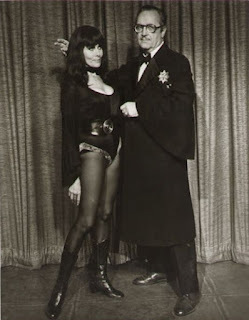 Here's Moona Lisa with
Here's Moona Lisa with Forrest J. Akerman
AKA Mr SciFi & the Akermonster
Moona Lisa, movie hostess, was actually Lisa Clark, a newscaster for KOGO (Channel 10) in San Diego, but I did not know that then. Seated amidst a pile of rocks in a dark lunar landscape, surrounded by roiling wisps of "moon smoke," she might have actually been on the Moon. Hey, no one had been there yet, so who was to say? And she did open every show with a sultry and seductive "Hello, Earthlings." If you see it on tv, it has to be true, right? With long, straight black banged hair, stiletto heels and a black catsuit showing more cleavage than any youngster then could imagine (it was a simple, more innocent and less complicated time), she was the "heartthrob of every ten-year-old boy in the city." And I loved her also because she also showed Godzilla.
I always admired the way Godzilla faced the travails of life, never giving an inch, never compromising about anything, never bowing to any foe or surrendering to the inevitable. While I was graduating high school and preparing for the onslaught of a cold, uncaring world, Godzilla was battling Gigan, a bio-engineered killing machine with curved swords for arms and a massive circular saw protruding from his chest. Godzilla did well.

When I turned 21 and could legally drink (actually I could have had a beer or whatever when I was 19 as long as I stayed on an Army post, but I didn't), Godzilla celebrated by kicking Mechagodzilla's butt for the second time. The old trope of fighting fire with fire just did not work out well for the robot's creators, but I could have told them that.
Turning 30 was bad for both of us. Some people tell me "age is just a number," but I also know there are a lot of delusional people in the world these days. I guess I take after my mother. I remember when she turned thirty. The house was filled with weeping and wailing, and I did my best to stay quiet and out of sight. Just a number, huh? I won't say that I spent the day crying over the end of the world, but I will admit I took the day off from work. And how did Godzilla celebrate his 30th birthday? He fell into an erupting volcano. Lucky guy. Obviously, I didn't die when I turned 30. I recall what my son said to me at the time: "Dad, you had to know that sooner or later you'd be 'over the hill.' You just didn't know there was a cliff on the other side." Harsh, but he did have a point.
Thirty years on, I turned 60 and so did Godzilla. I wanted to celebrate by having a birthday cake with candles, but we could not get a fire permit. The G-Man, however, celebrated in grand style, by staging a massive comeback in the Legendary film Godzilla, the first film by American filmmakers (we do not talk about the Matthew Broderick film) using the venerated Japanese kaiju. I had heard there might be a film in the offing as Godzilla's Diamond Jubilee approached, but I did not have much hope. Still, I wanted to commemorate it myself, so I wrote the following poem, which appeared in my collection Midnight for Schrödinger's Cat & Other Poems:
Godzilla at Sixty
The other kaiju on Monster Island look up, sigh, and shake their heads, And King Ghidorah gives it a triple nay;There he goes again, off to Tokyo and points westLike some trippy day-tripping tourist,Dressed in the loudest Hawaiian shirt anyoneâs ever seen, Picked up during that disastrous jaunt to the Big Apple,With a new digital camera strapped âround his neck,Raybans on those once laser-bright eyes,But with back-spines not much more than a glimmer anymore;Poor old fellow, taking off like heâs some young lizard just out of the egg, And on Bingo Night of all times!Rodan says heâs going senile,And while the Old Pterodactyl is pretty flighty himself, itâs painfully obvious to all: He wasnât quite the same after the Oxygen Destroyer; and Heâs been hit on the head by a lot of skyscrapers; and How many times can you put new flesh on old bones?He ought to take it easy like all the other Old Monsters,Play a nice game of Go with Baragon, even though he toots his own horn,Or Canasta with Gabara, Varan and Ebirah since theyâre always in need of a fourth,Or, if nothing else, curl up with a good book like Manda,Though when you're a giant snake what else can you do?But he does as he wants, as he always has, and always does,Saying, âAinât I the King of the Monsters?â andâItâs good to be the King,âWhich of course makes Junior do a face-palm on the throneAnd say, âHey, Dad, what am Iâchopped sushi?âBut even he knows thereâs no talking sense to the Old Boy,Telling him that the tsunamis from his walker are making a mess,That Cthulhu has called twice to complain about the noise,That he wonât get nearly the screen time he thinks he will,That heâs almost out of his radioactive arthritis medicine,And heâs probably going to be slapped with a lawsuit by the EPA;But, you know what, heâs smiling,And itâs been too long since anyone has seen those choppers in a grin;So maybe none of the other stuff really matters,Not the pain or the slowness or the inevitable retaliation by puny Humanity;Maybe whatâs important is thisâthat the World knows,That the World gets reminded by a ROAR like none other,That heâs still the King of the Monsters,And even at Sixty itâs good to be the King.
Of all the Godzilla films, including the latest ones from America, my favorite is Godzilla vs Destroya. It shows Godzilla in dire straits, yet striving forward no matter what, ignoring his impending doom to fight the menace loosed by the rediscovery of the Oxygen Destroyer technology from the very first film. We see that Dr Serizawa's sacrifice of his life to hide the secret was the right thing to do, but that it was for naught because of human stupidity. In this film, we see Godzilla making the same sacrifice to save us from ourselves, but we also see a great rebirth. The composer for this film stated that after he finished composing the music for the finale, he felt as if had died with Godzilla. I know what he means.
I have seen myself in Godzilla and sometimes see him in me, at least a little bit. I think perhaps there is something of Godzilla in all of us, something of us in him. There is at times a yearning to roar at the world. And who roars better than Godzilla?
And now something on a lighter note, my latest model building project:
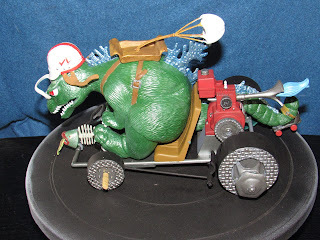
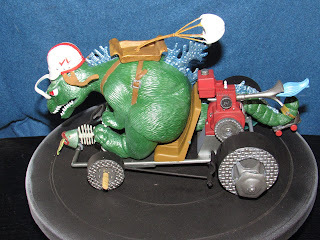
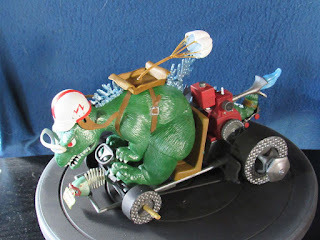
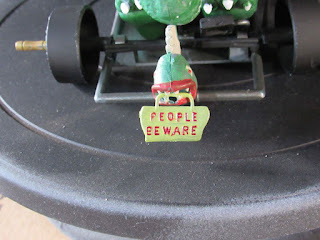
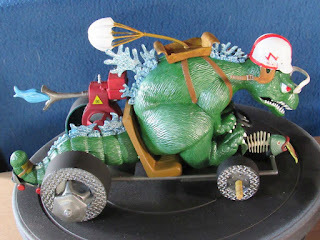

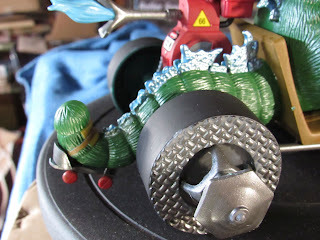

August 11, 2022
Better the second time around
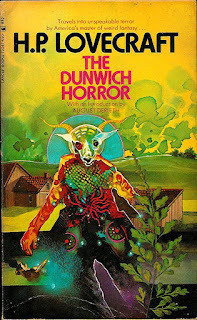 Beagle Horror editionIt was the Sixties. As other young fellows my age were discovering girls, drugs and the realities of a changing age (and all the problems that went along with them), I was discovering the works of fantasy writer HP Lovecraft, thanks to a casual remark made by my Homeroom teacher, Mr Robert Vigil. It was a providential introduction, as it turned out, giving focus to my own writing, which had edged unknowingly into Lovecraft territory. A few days later, I found myself at Pickwick's Bookstore in the College Grove Shopping Center (before there were "Malls") and came across the Beagle Horror editions of Lovecraft's work, including "The Dunwich Horror."
Beagle Horror editionIt was the Sixties. As other young fellows my age were discovering girls, drugs and the realities of a changing age (and all the problems that went along with them), I was discovering the works of fantasy writer HP Lovecraft, thanks to a casual remark made by my Homeroom teacher, Mr Robert Vigil. It was a providential introduction, as it turned out, giving focus to my own writing, which had edged unknowingly into Lovecraft territory. A few days later, I found myself at Pickwick's Bookstore in the College Grove Shopping Center (before there were "Malls") and came across the Beagle Horror editions of Lovecraft's work, including "The Dunwich Horror."One of the complaints I often hear about Lovecraft's stories concerns his writing style. Admittedly, there is nothing modern about it, not now, not even in his own time. Lovecraft wrote mostly in the early 20th Century (he passed away in 1937) so he was contemporaneous with Hemingway, Fitzgerald and Hammett. However, anyone unfamiliar with the milieu of Lovecraft's writing might think him a contemporary of Poe. Fortunately, I had been a Poe fan for many years, both of the stories and poems, and, later, the many films derived from his work. So, the form of the stories, the intricate narrative style and the breath-by-breath unfolding of the story as it worked to a shattering climax, was not a problem. What was a problem, however, was HPL's cosmic vision, his revelation of a universe inhabited by beings that cared nothing for humans, a cold cosmos we could never fathom, and the idea that humanity itself might be an accident or jape. It was heady stuff for a teenager.
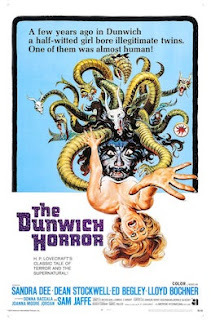 movie poster, 1970
movie poster, 1970Anyway, a few years passed and I learned that a film was going to be made from "The Dunwich Horror." I was quite excited. I've been a film fan all my life starting when I was in Kindergarten and walked to the Bay Theater in National City with the girls who lived across the street...it was a different world back then. One the sayings the Kidette and I have is, "Everything I need to know about anything, I learned from the movies or TV." Another saying I have, usually stated when contemplating doing something I probably shouldn't be doing is "No, I saw that film, and it did not end well." Often, the Kidette and I will converse solely in movie quotes, which drives many people nuts.
Anyway, the film was coming out in 1970, produced by American International. I had high hopes for it because I had seen the film The Haunted Palace, starring Vincent Price and directed by Roger Corman. Though the title was taken from a Poe poem and the film is considered one of his eight Poe-related films, the plot is actually derived from Lovecraft's "The Case of Charles Dexter Ward" and is very faithful to the novella, which was written in 1927, though not published until 1941 in Weird Tales. Since the film had been distributed by American International, which was producing the new film, I hoped "The Dunwich Horror" would exhibit the same fidelity to its source material. Alas, I was disappointed.
The film, directed by Daniel Haller (Pit & the Pendulum; Die, Monster, Die!) from a script by Curtis Hanson (Never Cry Wolf, LA Confidential) was deliberately recast into the turbulent Seventies. In doing so, writer and director defused much of the atmosphere of the story. Worse, they introduced a love interest (Sandra Dee as Nancy Wagner) for the loathsome and repulsive Wilbur Whateley (played by the non-loathsome and non-repulsive Dean Stockwell). It hit many of the tropes of the counterculture, including several extended psychedelic sequences, but did not include the brooding atmosphere of a decrepit town and the creeping horror that Lovecraft introduced though subtle hints and reveals about Wilbur Whateley's twin brother, who favored the father much more than did Wilbur.
The only characters in the film that struck the right note for me was Dr Henry Armitage (Ed Begley in his last role) and, to a certain extent, Sam Jaffee, who played "Old Whateley," though in the story he was "Wizard Whateley" and was a much more manic, imposing and demonic character. An interesting point to note in the 2009 remake of The Dunwich Horror (The Darkest Evil [or Witches] for the SyFy Channel), Dean Stockwell was back, this time as Dr Armitage, his adversary from the first film. I did not like the Haller/Hanson adaptation, and put it out of my mind for 52 years.
However, a few weeks ago, when I was home alone and looking for something to stream (we cut the cable years ago), I saw The Dunwich Horror offered on one of the streaming services. Things change with time, not the film, of course, but ourselves, our perceptions of things, and the times in which we live, which we have to adapt to, whether we like it or not. I found the film, for the most part, not as bad as I recalled. It was, of course, the same film, but I was no longer the dark-eyed fanboy who expected a faithful adaptation of the work.
At the time, I gave the film an F. Now, I give it a B-, a nice effort to modernize something that really did not need to be modernized. I had greater appreciation of the psychedelic sequences as an attempt to show a reality that could not be described, and the climax in which we saw the best FX that could be had in the pre-CGI Seventies. Many of the Seventies tropes (e.g., "What do you think of sex?") have not aged well, so have gone from hip and edgy to just dull and dated. Overall, though, I think the film is fairly respectful to the source material, if not very faithful. Over the years, I have learned you have to put up with such things, and even expect them, from Hollywood.
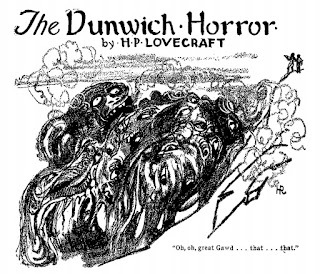 An illustration from Weird Tales, 1929
An illustration from Weird Tales, 1929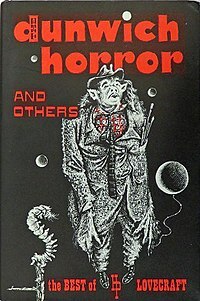 The Arkham House edition
The Arkham House edition
July 6, 2022
The Book was...Different
All of us who love both movies and books have made the comment at one time or another: "The book was better than the film." This usually happens when we hear that a book we really like is getting the Hollywood Treatment. Simultaneously, we are excited and terrified. Will the film be as good as the book? Will it contain everything we loved about the book? Of course, these days, when Hollywood (and other film capitals) seem intent on trashing the past, trampling on our beloved franchises, and fusing propaganda and entertainment, we often wonder, "Will the film be anything like the book?" Of course, we don't really need a struggling NWO to trample on books. Hollywood has been doing that for years.
 I recall when the film World War Z was released. One review I read after its debut stated, "The film has everything you loved about the book's...title." At that time, I had not read the book, so I did not understand exactly what he meant. When I finally read the book, I understood. The film was forgettable overall, but I remember it had Brad Pitt in it and was shot in every exotic location willing to give the filmmakers a tax break. Alas, no underwater zombies or epic battles, just bland characters, silly situations and a quick fix to the world's end. Prior to penning World War Z: An Oral History of the Zombie War, Max Brooks wrote the satirical, yet extremely practical The Zombie Survival Guide, which I keep on the nightstand next to my bed...you know, just in case.
I recall when the film World War Z was released. One review I read after its debut stated, "The film has everything you loved about the book's...title." At that time, I had not read the book, so I did not understand exactly what he meant. When I finally read the book, I understood. The film was forgettable overall, but I remember it had Brad Pitt in it and was shot in every exotic location willing to give the filmmakers a tax break. Alas, no underwater zombies or epic battles, just bland characters, silly situations and a quick fix to the world's end. Prior to penning World War Z: An Oral History of the Zombie War, Max Brooks wrote the satirical, yet extremely practical The Zombie Survival Guide, which I keep on the nightstand next to my bed...you know, just in case.Not long after I read the survival guide, I had occasion to summon the police to help with a car parked across my driveway. That morning, I had had to drive the Wife's car down the sidewalk till I could pull onto the street so she would not be late for jury duty. When the officer arrived, he saw the problem and called a tow truck...as it turned out, the guy who drunkenly parked there had just got his car out of impound because it had been towed after blocking another driveway. While we were waiting for the tow truck, the officer noted I had a new driveway gate up by the house. He commented on how well built it looked, an improvement on the old gate it had replaced. I told him, "Well, yes, it is well built, but it won't hold off anything worse than a Zombie Level 1 siege." Without a pause, he replied, "Hopefully, it won't come to that, and perhaps the Zombie Apocalypse will pass Chula Vista altogether." Ah, ya gotta love the officers of the CVPD.
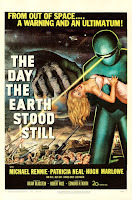
The Day the Earth Stood Still (1951) was a film that had quite an impact on me as a kid. Of course, I did not see it when it first came out, but did around 1959 or so. At the time I just accepted how it was portrayed on the small screen, and said "Klaatu barada nikto" ("Klaatu dead. Repair him. Do not retaliate") like everyone else who lives and dies by film quotes. It was not until years later that I discovered the basis of the film was a 1940 short story entitled "Farewell to the Master" by Harry Bates. It appeared in the October 1940 issue of Astounding Science Fiction (now Analog-Science Fiction/Science Fact), but I did not come across it till much later, in a 1994 Barnes & Noble anthology, Reel Future edited by Forrest J. Ackerman & Jean Stine. What do the story and film have in common? Not a lot, really.
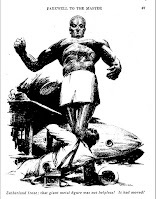
A spaceship (not a flying saucer) lands outside the Capitol in Washington DC, an alien named Klaatu emerges with a giant robot (Gort in the film, Gnut in the story), and Klaatu is shot. In the story, he dies, his body is placed in a mausoleum and the robot stands unmoving. In the film, the wound is not fatal, Klaatu hides in the general population and story goes from there, eventually ending as a warning against the Earth about the use of nuclear weapons. It's a well-made film, but it's really just a message film, tying its impact into a theme that was more important then than it is now. The story, however, is an "idea story," like many of the stories that emerged from Astounding SF in the 30s and 40s. The precipitating events (the landing and Klaatu's death) happen years prior to the start of the story, and we first see Gnut through the eyes of a reporter who, at night, sneaks into the museum built around the motionless 8-foot-tall humanoid robot. There, he sees the robot move, enter the ship and attempt to reconstruct Klaatu from a recording. The recording is flawed, so the new Klaatu dies (again) and the reporter provides a flawless recording so the robot can use it back home to bring Klaatu back to a stable life. Just before the robot heads back to the stars, the reporter asks him to tell his master, the new Klaatu, that the death was a terrible accident. The robot's reply: "You misunderstand. I am the master."
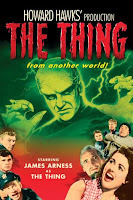 The Thing from Another World was another film that made an impression on me. Unlike The Day the Earth Stood Still, I did not see this one till much later in life, probably in my mid- to late-teens. As I watched it, I felt a strange sense of familiarity. I watched the scientists at an Arctic research station find a flying saucer that had been buried under the ice for a long time. I got a little chill as I saw them arranged in a perfect circle around the spaceship's circumference. Of course, I knew all about flying saucers because I was heavily into studying them, something that had fascinated me ever since seeing a circular craft in the night sky when I was about nine or so. When the scientists found the pilot frozen in ice and brought it inside the research station, the reason for the familiarity finally struck me--it was the same plot as a 1938 story called "Who Goes There?" by Don A. Stuart (John W. Campbell Jr). I settled back to watch the story I knew so well unfold...and was thoroughly disappointed.
The Thing from Another World was another film that made an impression on me. Unlike The Day the Earth Stood Still, I did not see this one till much later in life, probably in my mid- to late-teens. As I watched it, I felt a strange sense of familiarity. I watched the scientists at an Arctic research station find a flying saucer that had been buried under the ice for a long time. I got a little chill as I saw them arranged in a perfect circle around the spaceship's circumference. Of course, I knew all about flying saucers because I was heavily into studying them, something that had fascinated me ever since seeing a circular craft in the night sky when I was about nine or so. When the scientists found the pilot frozen in ice and brought it inside the research station, the reason for the familiarity finally struck me--it was the same plot as a 1938 story called "Who Goes There?" by Don A. Stuart (John W. Campbell Jr). I settled back to watch the story I knew so well unfold...and was thoroughly disappointed. 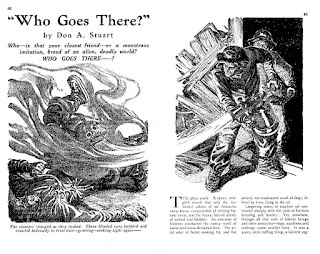
Now, don't get me wrong. The film is well-written, well acted and the photography is superb, but it is the story of a blood-drinking vegetable that ends up getting fried. In the story, the alien is a protean predator, highly intelligent and intent on getting out of the Arctic where it can use its shapeshifting powers and ability to reproduce asexually to displace humanity. The film's strength was in producing a claustrophobic horror, much as we experienced in the film Alien, which was based on an uncredited story by A.E. van Vogt. In the story, the focus is on paranoia. Because of its powers and intelligence, the alien can be anyone, from the sled dog to the fellow sitting next to you. I have always held the opinion, if you are going to base a film on a story, film that story, not something that is nothing like the story. Otherwise, just come up with an original script. Now, this was not the end of "Who Goes There?" and Hollywood, because it served as the basis for John Carpenter's 1982 The Thing. In this version, they get the creature's powers correct (very graphically), but the film...well, most people seemed to like it.
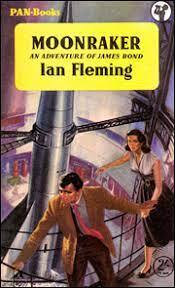 There's really no end to the number of films that wasted its source material, but I especially wanted to mention 1979's Moonraker, the 11th film in the James Bond franchise, and one of the worst films in that franchise, though it has stiff competition from Quantum of Solace, Spectre and (most especially) No Time to Die. The odd thing about Ian Feming's Moonraker is that it is one of the best books in the series. What do the film and the book have in common? A title. That's all. What's different between the book and film? Everything. The moronic and insulting film is so vastly different that instead of re-issuing the standard movie tie-in of the original book, it was decided to hire Christopher Wood to write a novelization of his own insipid screenplay, though the title of the book was James Bond and Moonraker. It was claimed that the filmmakers did not moviegoers to be confused by the differences between the two. Personally, I think they did not want anyone to see how much better Fleming's book was than the film, which, somehow, went on to become the highest grossing film of the series until the superior Goldeneye came along. Just in case you wondered--no, I really did not like the film Moonraker.
There's really no end to the number of films that wasted its source material, but I especially wanted to mention 1979's Moonraker, the 11th film in the James Bond franchise, and one of the worst films in that franchise, though it has stiff competition from Quantum of Solace, Spectre and (most especially) No Time to Die. The odd thing about Ian Feming's Moonraker is that it is one of the best books in the series. What do the film and the book have in common? A title. That's all. What's different between the book and film? Everything. The moronic and insulting film is so vastly different that instead of re-issuing the standard movie tie-in of the original book, it was decided to hire Christopher Wood to write a novelization of his own insipid screenplay, though the title of the book was James Bond and Moonraker. It was claimed that the filmmakers did not moviegoers to be confused by the differences between the two. Personally, I think they did not want anyone to see how much better Fleming's book was than the film, which, somehow, went on to become the highest grossing film of the series until the superior Goldeneye came along. Just in case you wondered--no, I really did not like the film Moonraker.Well, I hope enjoyed looking at some films that wasted their source stories. There are a lot more, and you probably have your own favorites. Now, that's not to say that there are not films that showed respect and fidelity to their source books. I can think of several. Hopefully, we'll get a change to take a look at a few of them.
June 7, 2022
Metaluna Mutant
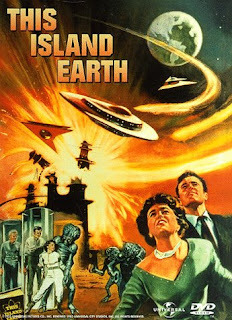 I know I saw the film This Island Earth in a theater, probably the Bay Theater in National City, but since it came out in 1955, it must have been re-released sometime prior to 1963. It's a very good film, one of my favorites, despite the rather simplistic plot that, in the end, goes the only place it could go--nowhere but where fate dictated. Unlike other films of the period, it's not as dated as it might be, possibly because it's set almost entirely within a secluded conclave of scientists and on the planet Metaluna. Neither setting provides interaction with the then-current US society, the main reasons films lose relevance as audiences change. For example, Godzilla (1954) is still a relevant film (I don't think the modern Godzillas from Legendary will fare as well) because the focus is on the monster not the people, whereas The Giant Gila Monster (1959) is a dated rock-and-roll curiosity piece with a big lizard thrown in, though I still find it enjoyable, the b&w version more than the colorized bastardization.
I know I saw the film This Island Earth in a theater, probably the Bay Theater in National City, but since it came out in 1955, it must have been re-released sometime prior to 1963. It's a very good film, one of my favorites, despite the rather simplistic plot that, in the end, goes the only place it could go--nowhere but where fate dictated. Unlike other films of the period, it's not as dated as it might be, possibly because it's set almost entirely within a secluded conclave of scientists and on the planet Metaluna. Neither setting provides interaction with the then-current US society, the main reasons films lose relevance as audiences change. For example, Godzilla (1954) is still a relevant film (I don't think the modern Godzillas from Legendary will fare as well) because the focus is on the monster not the people, whereas The Giant Gila Monster (1959) is a dated rock-and-roll curiosity piece with a big lizard thrown in, though I still find it enjoyable, the b&w version more than the colorized bastardization.The film is taken from the novel This Island Earth by Raymond F. Jones. Though the book was published in 1952 by early SF publisher Shasta, it actually appeared in SF pulp magazine Thrilling Wonder Stories as three separate novelettes: "The Alien Machine" (June 1949), "The Shroud of Secrecy" (December 1949) and "The Greater Conflict" (February 1950). Though the film and the book follow the same plotline from the beginning, with physicist Cal Meacham receiving a strange machine to build, followed by an invitation to a secret scientific society and a ride in a robot-plane, they diverge widely at that point. The book continues almost as a mystery novel as the purpose of the society is explored and we find a great interstellar war is raging around the Earth, that the Llannans (as the aliens are called in the book) as using Earth just as US and Japanese forces used small Pacific islands during WW2...the inhabitants could not understand the nature of the conflict, but they could be used to build things, airfields in the case of the island natives, "interociter" machines in the case of the shanghaied scientists. It explains the title of the book, an allusion omitted from the film.
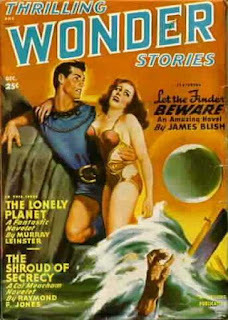 The Dec 1949 issue of TWS
The Dec 1949 issue of TWS"The Shroud of Secrecy,"
2nd in Jones' trilogy
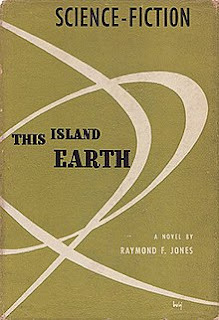 Shasta's first edition of the novel, a very
Shasta's first edition of the novel, a veryminimalist design; the re-issue used the movie
poster as a basis for the art.
The film, which was released as a double-feature with ("sigh") Abbott & Costello Meet the Mummy did fairly well at the box office, earning $1,700,000, and good reviews from critics who praised the literate script and special effects. While the film still holds a favorable rating with fans and film historians, it took an undeserved hit when it was lampooned in Mystery Science Theater 3000: The Movie. Well, I never cared that much for the series anyway The book was mostly well-received, though some reviewers (notably Kirkus) thought there were too many loose ends left hanging and too much "labor baiting" by the author. The film is available on DVD/Blue Ray, though you can catch is on broadcast TV sometimes or watch it on YouTube. The book has been out of print for a long time, but is now available, like a lot of older writings, as an e-book. A print version of the story was included in the 1994 anthology Reel Futures published by Barnes & Noble Books, a very interesting collection I should highlight in the near future.
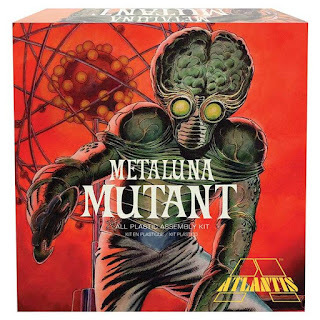 Metaluna Mutant Model from Atlantis
Metaluna Mutant Model from AtlantisSo, you ask, why bring up a 70-year-old film (and book) that most people have not seen or read, other than because I have odd tastes. Well, one of my favorite aspects of the film (other than seeing an airplane in flight snatched by a flying saucer...true facts!) is the Mutant engineered by the Metalunans (as the aliens are called in the film) as slave labor. It was designed by makeup artist Bud Westmore (uncle of Michael Westmore of Star Trek fame). Even today, it remains an effective design, though the final project did not quite match Westmore's original concept...the limitations of the human body are so annoying. Originally, the Mutant's legs were supposed to match the arms.
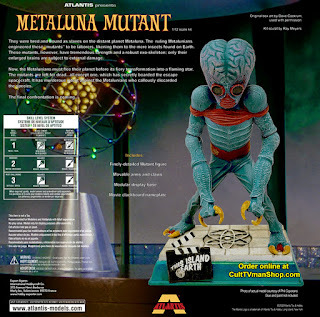 Back of the box showing finished model
Back of the box showing finished modelAtlantis Toy & Model Company, one of the few US model companies remaining, issued a 1/12 scale model of the Mutant from the film. Yes, I had to get it. If there are any model builders, or former ones, this might strike a familiar note. That's because the Aurora Model Company was going to issue Mr Mutant as part of their "Famous Monsters of Film" series, joining Frankenstein, the Mummy and the Wolfman. The dies were cut, but, unfortunately, it didn't happen, and the company went under shortly afterward. From this point on, it's just going to be pictures from my model build, in which I took some liberties with color (because I could) and added a lobby card to replace the b&w graphic provided for the clapboard, so if you're not interested in models, thanks for reading this far. I really appreciate your interest and support. Do find time to watch the film or read the book.
 The base: ivory top, dark blue background, with gold
The base: ivory top, dark blue background, with goldatomic sigil; lobby card (remember those?) added by me.
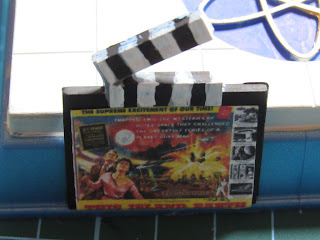 Close up of lobby card.
Close up of lobby card. "It's alive! It's alive!"
"It's alive! It's alive!" For the trousers, I used Vallejo Acrylic's Wood & Leather
For the trousers, I used Vallejo Acrylic's Wood & LeatherPaint Set to create "light leather," a mix of Dark Sand/Japanese
Uniform with washes of Flat Earth and Smoke, then Dark Sand
again for highlight. All painted areas were first covered with
Vallejo USN Ghost Grey Surface Primer.
 The feet and "hands" are a slightly different color than the
The feet and "hands" are a slightly different color than thebody. I used a 60/40 mix of Metallic Turquoise and Metallic
Arctic Blue from Folkart. Claws are Vallejo Bonewhite.
 A face only Mutant Mom could love.
A face only Mutant Mom could love. I don't know why he has a "space bra."
I don't know why he has a "space bra."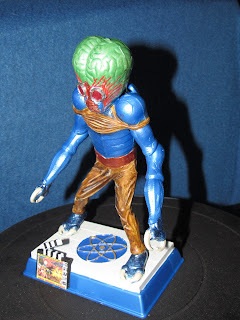 Yes, the brain was bluish, but it
Yes, the brain was bluish, but it shouted "Green!" at me. The Mutant
made me do it. That's my story.
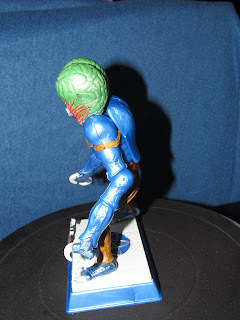
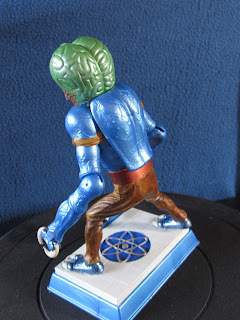 To be honest, I don't understand the purpose of
To be honest, I don't understand the purpose ofthe "hump" or how it goes over the "space bra."
Is it armor or organic? It looks both.
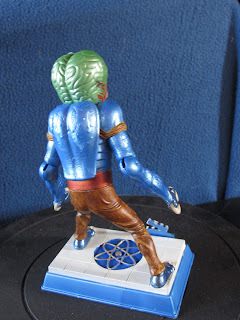
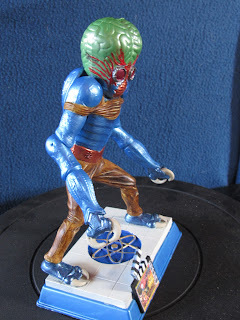
 Another view of the trousers. It was the first
Another view of the trousers. It was the firsttime I've used such a complex layering on a model.
 The Mutant measures 7" (7.5" with the base). At
The Mutant measures 7" (7.5" with the base). At1:12 scale, one inch equals one foot.
The Metaluna Mutant has been a favorite of fans for years. I think it may be because he fulfills so many genre tropes of the times: bug-eyed monster (BEM), exposed big brain, popping veins, claws, etc. All he needs is a scantily clad space lass on his arm and he could have graced the cover of Thrilling Wonder Stories. As it is, he'll have to be satisfied with the cover of Famous Monsters of Filmland, that venerable chronicle of weird and wonderful movies founded by James Warren (Creepy, Vampirella, etc) and Forrest J. Akerman (AKA "The Akermonster" and "Mr Science Fiction."
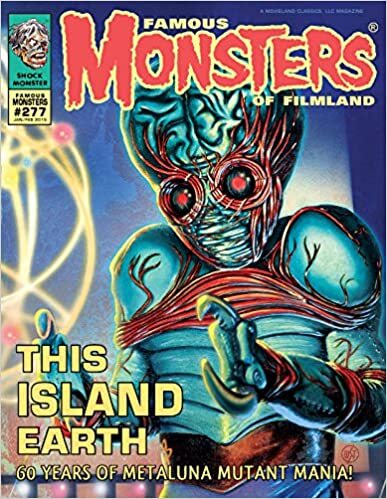
May 19, 2022
A Holmes Duo
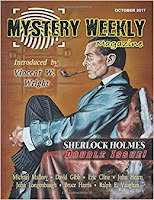
In 2017, I sent a Sherlock Holmes pastiche to Mystery Weekly Magazine for their annual tribute to the Great Detective. This was a little shilling shocker called "London After Midnight." If the title sounds a bit familiar, it's because it was a 1927 silent film starring Lon Chaney Sr, helmed by Todd Browning. Unfortunately, it is a lost film, the last surviving copy being destroyed in a fire in the 60s. I did see a recreation of the film, using the original script and stills from the production. Even in that version, it was memorable. In 1935, Todd Browning remade his film as a talkie, with Bela Lugosi in Chaney's role. It is a good film, but not as memorable. I've always liked the title, with its evocation of gas-lit London and thick fogs, so when a chance to legitimately use it (the story does start after midnight) I took advantage.
When others write Holmes pastiches, they seem intent on recreating a Conan Doyle story, right down to the tone, types of crimes and the use of Watson as a filter. I have usually taken a different route. Ever since I created the Holmes/Lovecraft mashup (see "When Sherlock Holmes First Met HP Lovecraft"), my first choice is to embroil Holmes in situations such as Conan Doyle never thought of and which would have sent Watson scampering home to one of his many wives. When I told the editor my submission might be "a little weird," I was told, "We like weird." So, Holmes was going to again enter Lovecraft territory.
In stories, I try to give Holmes third-person narrators or unique first-person narrators. In this case, I chose the latter and drew upon my inner P.G. Wodehouse for a Bertie Wooster-like character. Shades of young men in spats! An advantage of using a unique voice is that different aspects of Holmes come to the fore and we at times get a more honest, sometimes more critical view of Holmes. In this case, the narrator is a little cheeky, a bit esoteric and probably drinks a few too many gin & tonics.
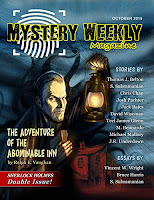
A couple of years later, I was again asked to submit a story for the 2019 Holmes issue. This time, I decided to use a third-person narrator and set the tale during a time in Holmes' life that is rarely explored. It's called the Great Hiatus and is the three-year period (May 1891 - April 1894) following his apparent death at the hands of Professor Moriarty, as related in "The Final Problem." Holmes returned to the public eye in "The Adventure of the Empty House" (see my previous post for what really happened the night of his return), but he was always reticent about his activities during his absence from London. Relatively few stories are set during that time in his life, possibly because of that reticence, but possibly, also, because his true identity could not be shared with any of the people he met or helped. Not only was it a chance to explore Holmes' life when to the world at large he was dead, but it provided the opportunity to get Holmes out of London, out of England, which I did by setting the story in a small Italian village with a dark past, and darker secret.

A week or so ago I came across the contracts for the stories and realized that the exclusivity period requested by the publisher (12 months from date of publication) had lapsed. Though not enough for a full collection, I thought a Sherlock Holmes duo would make a nice quick read for someone needing a brief diversion from worldly anxieties. Sherlock Holmes & the Mythos: Two Tales of the Cthulhu Mythos is now available as an e-book on Amazon. Because of its brevity, it will be digital only. As an extra bonus, I added a gallery of original Lovecraftian art at the end of the publication.
May 2, 2022
Black Cat Weekly
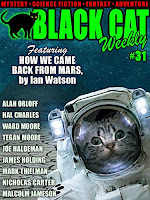
If you've not come across Black Cat Weekly from Wildside Press, you are missing a great source of entertainment for literary omnivores. Each issue (as I write this, issue #35 has just come out) contains a number of stories in various genres, both old and new. To be honest, this has been a recent discovery for me, so I find myself in the situation of both keeping up and catching up.
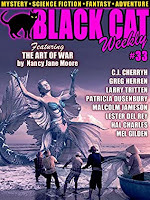
Although I greatly enjoy the novels and stories from such writers as Lester del Rey, Henry Kuttner and Malcom Jameson, I find myself drawn to the interviews conducted by Darrell Schweitzer. There is an art to interviewing, one that not even journalists often appreciate. It's not a matter of asking questions, but of asking the right questions. Back when I was an Army photojournalist (when journalists were actually journalists) I found interviews to be the most difficult, yet most rewarding of assignments. I appreciate the deft touch Schweitzer brings to the task, as well as the profound comments elicited from such subjects as Fred Saberhagen, CJ Cherryh and Thomas M Disch. The interviews are "vintage," so they are a bit like literary archaeology, but that does not take away from my enjoyment of them in any way.
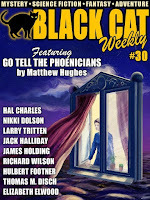
Previously, each issue of the e-mag was $3.99, but the publisher recently reduced the price to $2.99, perhaps to make it more attractive to new readers. At either price, however, it is a heck of a deal. Honestly, I derive more pleasure from it than I do modern monthly print magazines. Give it a try. I think you'll really like it. You can get it directly from the publisher's website (link above) or from Amazon.
April 1, 2022
A Novel for for Roger Corman
I've always liked Roger Corman's films and television series. It's something of a guilty pleasure, but at least it's one than I can admit to now that Roger Corman has been around long enough (95 years) to acquire a patina of respectability. Of course, it's easy to admit to liking his Poe-series films because they were so well done by anyone's standards, but it takes a measure of fortitude to admit liking Beast With a Million Eyes, It Conquered the World or ("gulp") Attack of the Crab Monsters. One thing I always liked about his films is that you often never really knew what was coming. A safe cracking job segues into a monster movie in Beast of Haunted Cave, a film about a bunch of primitive cave dwellers becomes a warning about the future in Teenage Caveman, and a tale of unrequited love takes on a botanical twist in Little Shop of Horrors. I really wanted to capture that sense of Corman's genre weaving, so I wrote Behind Thick Walls: An Apocalyptic Crime Novel.
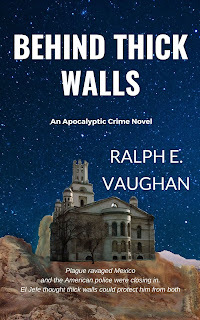 It starts out as a gangster novel, focusing on a new recruit to the infamous Diablo Crime Cartel, run by Antonio Carrillo, known to one and all as El Jefe. This is a time of plague for the novel's characters, but nothing as mild as what we in the "real" world have suffered through. No, they have N1M1, otherwise known as Rot, a disease of unknown origin (unlike Covid) that results in the body falling apart, and I don't mean that metaphorically.
It starts out as a gangster novel, focusing on a new recruit to the infamous Diablo Crime Cartel, run by Antonio Carrillo, known to one and all as El Jefe. This is a time of plague for the novel's characters, but nothing as mild as what we in the "real" world have suffered through. No, they have N1M1, otherwise known as Rot, a disease of unknown origin (unlike Covid) that results in the body falling apart, and I don't mean that metaphorically.El Jefe has moved his base of operations to his Citadel in a remote section of Mexico and practices a strict, some might say brutal, regimen to keep Rot at bay. The Mexican government leave him alone now that they have more important fish to fry, so to speak, but the American Department of Justice still wants his head on a platter, also so to speak. Beyond the diplomatic problems of attacking another country (though Mexico is in no position to protest), the Citadel is very well protected against ground and air assaults. Unfortunately, the DOJ has been spectacularly unsuccessful in gathering intelligence about El Jefe's defenses. Yes, they could drop a bunker-buster on the Citadel, but they really want El Jefe in a supermax prison much more than they want a smoking crater in Mexico's sovereign soil.
Then comes a man from out of the the desert who claims to be a doctor and a scientist on the trail of the origin of Rot. But he also claims that Rot may "not be of this Earth," so he may just be a lunatic. Or a prophet. Times of plague bring about all sorts of manias and rabble rousers exhorting the masses, men who cry Doom and Damnation to a dying world. This might be helpful to El Jefe, or he might be a harmless kook. Or he might be a spy for the Americans.
Blending genres can be risky, even jarring to the reader. There is always the risk that the science fiction fan may be turned off by the crime and noir elements, that the crime and thriller fan may find the science fiction and dystopian aspects off putting, or that aficionados of dystopian fiction may not be enthused by the crime and SF tropes. But, I think there is probably a convergence of readers somewhere in that trio of genres, and maybe even a few Roger Corman fans.
The book is currently available as an e-book and print edition on Amazon, and as an e-book wherever digital books are sold. Thanks for your support,
 Click the button above to
Click the button above to purchase at your Amazon store
 Click the button above to buy everywhere else
Click the button above to buy everywhere elseMarch 20, 2022
Aiming for the Moon
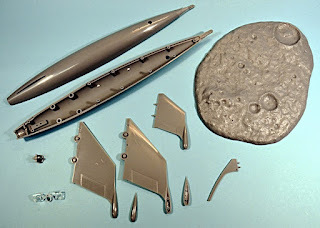
After almost five decades, I finally had the time and space to get back into a hobby that I enjoyed very much as a kid: building scale models. Of course, things had changed somewhat, not only in the hobby and in my own life, but in the world as well. Models were much more expensive and harder to find since model shops seems to be heading toward extinction, as are bookstores. As a lad, my hands were more nimble in handling small parts and they were not stricken by arthritis. Not everything has changed for the worse, though. I am much more patient now and and there are loads more resources available now, primarily the internet and YouTube. There was no one to ask about model building when I was a kid, but now all the information I want is just a few keystrokes away or accessible with an Amazon Firestick.
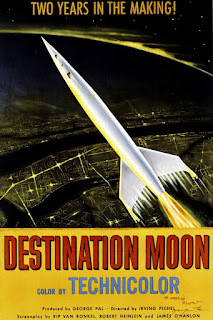
One of the models I built was the Luna, the spaceship from Destination Moon. It was not a complicated build, but still very fun. It's more of a painting project, really, than an assembly project. The ship itself is classic silver, hand painted, not sprayed. The based was very colorful by the time I got through with it, using various metallic acrylics, as I did when I built the Dick Tracy Magnetic Space Coup.

I've seen the film several times, but decided to read up on it anyway. I was rather shocked when, according to Wikipedia and IMDB, the film was based on the Robert A, Heinlein novel Rocket Ship Galileo. I knew this was wrong, that the the film was based on his novella The Man Who Sold the Moon, but everywhere I looked confirmed the information. I wondered, at least briefly, if I had slipped into an alternate history, you know the kind of place where the children's books about the Bears are Berenstein rather than Berenstain, or where Nelson Mandela did not die in prison.
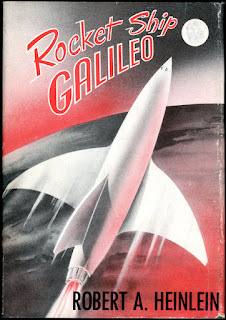 I read Rocket Ship Galileo in second or third grade, and several times since then. For those who don't know the plot, three teenagers go to the Moon in a rocket ship invented by one boy's uncle. There they discover a secret Nazi base. There are no kids in the film, no uncle, and definitely no Moon Nazis. The film has much in common, however, with The Man Who Sold the Moon, an industrialist building a lunar rocket and using his project to lead humanity into space. Well, I know films often do not come out much like the books upon which they are based.
I read Rocket Ship Galileo in second or third grade, and several times since then. For those who don't know the plot, three teenagers go to the Moon in a rocket ship invented by one boy's uncle. There they discover a secret Nazi base. There are no kids in the film, no uncle, and definitely no Moon Nazis. The film has much in common, however, with The Man Who Sold the Moon, an industrialist building a lunar rocket and using his project to lead humanity into space. Well, I know films often do not come out much like the books upon which they are based.David Morrell, author of First Blood, made a comment in his book, Lessons Learned from a Lifetime of Writing, that when Hollywood gets their mitts on a book, it will be changed in ways the author never dreamed. In the film contract for First Blood was a clause for a sequel. He wanted to know how the heck there could be a sequel since nearly everyone in the book died. He was told (paraphrasing): "Listen, kid, if the film is successful and they want to make a sequel, there will be a sequel, even if they have to turn it into a pirate musical set on a submarine." There are reasons why I live in dread of success, and having to deal with Hollywood comprises almost all of them. Still, no teenage inventors, no crazy uncle and, most of all, no Moon Nazis. On the other hand, look what Hollywood did to World War Z ("The film contained everything you loved about the title"), I am Legend and Who Framed Roger Rabbit.
However, if one wants Moon Nazis (and who doesn't?), there's always the unabashedly satiric, goofy and occasionally funny Iron Sky and its rather pulpish sequel Iron Sky: The Coming Race. Personally, I think it easier to make a case that Iron Sky is a loose (very loose) adaptation of Rocket Ship Galileo than was Destination Moon. It's the Moon Nazis, you know.
